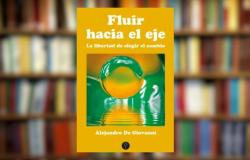They make encounters every week, help themselves in their creative process and perform exercises to stimulate their artistic facet. For the collective, the books are not only text, but communication devices that propose unique trips. This is explained by Eva Casanueva, coordinator of a group composed of 29 people, who seeks to claim that the novels are not a “reading of one phrase after another”, but that they suppose an “unimaginable proposal” in which there is a “author who wants to tell something.”
“People consider a book as if it were only text or as if they were part of a catalog,” Casanueva tells eldiario.es, “so it is necessary to cultivate so that people understand that the book can be many things.” Among them, an M-30 that denounces the rise in rental prices, a compilation of 80 card headers that Emilia Pardo Bazán sent Benito Pérez Galdós between 1883 and 1915, a red filter that allows to see-and read-the female stories invisible over time, or a compendium of pages that only pray “blablabla”.
A book can be so many things that it is important to put the focus on which art not only resides in the background, but also in form. That is the conclusion reached by artists such as Eva Casanueva, who during the year strive to get to the audience made by handmade specimens, with their “own magic”: “You put their hearts, hands and eyes. It is not as if an editorial printed you a lot of once, here you cut the pages and guillotines, which makes the books more yours and you take your children.
They do not have large editorial groups behind, their distribution is very complicated and reaching people is a very difficult challenge. Their stories resurface more strongly than ever in fairs where they can make themselves known. However, Sant Jordi or the Madrid Book Fair are not dates that have marked on the calendar. For them, one of the great appointments is mutant books. The fair, which brings together artists and independent stamps from all over the world, celebrates creative freedom and rupture with the standards of the publishing industry mainstream.
His twelfth edition, which was held in the house on May 25 to 27, recognized one more year that each work is a declaration of intentions: it matters both what is told and the way it is counted. The paper, the binding, the folds, the unusual formats … everything speaks, everything communicates. “This fair value the artist’s book, the fanzine, which leaves the rule of conventional publishers,” says Begoña, of the Bilbao Printing Another Press. “The editorials that can attend a book fair in a large city are editorials with a very extensive catalog because they demand it to participate,” he adds, highlighting that in mutant books “different pieces are exposed to what you find in a neighborhood bookstore.”
Begoña points out that, unlike the works of a large editorial group that “you can find in a lot of sites”, which is sold in fairs such as mutant books are “very exclusive” specimens: “There are titles that will be here this weekend, the 100 that have been printed, otherwise.” Among his favorites, From our eyesborn under an idea of the illustrator Donostiarra An Arzelus and her friend Sara Halo. “The woman always comes out of the classic Greco -Roman myths, so Arzelus literally put on the gender perspective filter about history and, instead of talking about Perseus, he speaks of Medusa,” says Begoña. With the intention of making the invisible visible, a red filter on the pages allows reading what without that filter would remain hidden, which is the female version. The work is edited in Spanish and Basque.
Following the same claiming intention, What do feminists do to art? Blanca Arias is another of the novels exhibited. His seal, Holy Heaven, arises after “a void” that perceived their editors “between feminist theory and fiction.” “Right now there is a reaction against all rights, starting with the rights of trans people,” Sofia and Blanca explain to this newspaper. “Fiction has immense power to accompany us and that is why we publish these books, which we believe have a hole in society and that they can make more people dream and fight,” they add. The idea was to “give a hole to some authors” who saw that “they were not being published at a larger level.”
For his part, Begoña agrees that, “precisely because it is something a little more underground”, Here is space to “talk again, fight and continue fighting for something we thought I was already conquered.” “The third wave of feminism … I do not know how many are going to need. In the times, with the large amount of information that is poured, especially misinformation and bulos, there is a lot of voice to a niche of inflaers that are already putting stones on the road,” says Editor of Another Press. “Any excuse to talk about it, reflect, question your own prejudices and have the will to learn, educate and open your mind to the world, it is already something wonderful. And I think forums like this enhance dialogue. There are people who come from all over the world,” he adds.
One of those stamps that go from country to country appearing by fairs is Valiz, of Dutch origin. This weekend has been in Madrid, but the next one goes to London, then to Berlin and then to Poland. His books have a “critical optics”, and cover from identity or masculinity issues to projects queer, feminist themes or other visions towards artistic education. “They bring different approaches to a fact, regardless of whatever, to feed the ability to empathize and have an open look on our reality, which is diverse always say what they say,” says Irene, in charge of her section in mutant books.
Valiz’s most curious thing is that they also sell damaged specimens, but at a lower price with respect to the original. “As the books go on tour, they are bruised between people open and take them out, and in the end they spoil a little. Then we have a couple of book boxes that have lived that and have a small discount depending on their state,” Irene clarifies. “Not to get rid of them as they do with the tomatoes that are bad, since what matters is the content inside if you do not want it as an object of exposure, you take it for 10 euros less and that you save,” he says.
Even so, despite the attraction caused by these works, “they are quite suicidal projects because economically they do not go on account.” This is stated by Gary of Infinite Beauty, an editorial that started 20 years ago in Bilbao. “These books, which in themselves are works of art rather than books on art, do not enter the commercial circuit and in other places these initiatives are not accommodated,” he says, highlighting that “they explore other types of visual narratives and work what is the format of the book itself.” His bestseller es Pornapados of Paloma Blanco, edited as if it were a porn magazine with the same type of binding, staple and paper, and in which the author changes sexual situations for other daily scenes such as watching TV, dancing, reading or doing sports, but keeping the same sides of ecstasy of the original photographs and the same erotic texts that accompanied them.
Another author who presents interesting works is Nacho García, who picks up cards that Emilia Pardo Bazán sent Benito Pérez Galdós, or the answers he obtained when on March 7, 2023 he asked 100 users of the #Sexo de Chateagratis.net room for his favorite artist. Also, the well -known novelist Esther García Llovet is a presence with Smarter than idealistwhere it takes the role of the M-30 as a border to determine the price of housing in those neighborhoods that are on one side or another of it. Séverine, of the Gimmefive project composed of five women, explains that the work portrays the “limit between those who can and those who cannot.”
Séverine says that Esther García Llovet “toured the M-30 taking photos of empty spaces, trying to see what surface they have and what type of value they could have on the market.” They, with their budget, made “a leporello” [acordéon]which works as a “photographic object” and that can be put on a table as if it were the M-30 of Madrid. “We always try to find the form that coincides with the background,” says the editor, who visits the Mutant Book Fair for the last time because the project closes “due to personal issues.” “On the way, we learned, grew up and had fun more than we imagine,” they communicated to their followers.
In a world saturated with productions and releases, mutant books value artisanal work, experimentation and risk. Books are not only read: they are touched, explore, they are discovered. These artists try to reinvent the concept of publication, merging traditional techniques with contemporary approaches, claiming a better society and using graphic design, illustration, photography and writing to give voice to issues that danger of becoming invisible. For Eva Casanueva, “this kind of thing is done by personal necessity of each one, for taking away projects and being able to build others”, which means that, “until you pour it into a book, you do not give it the end.”






